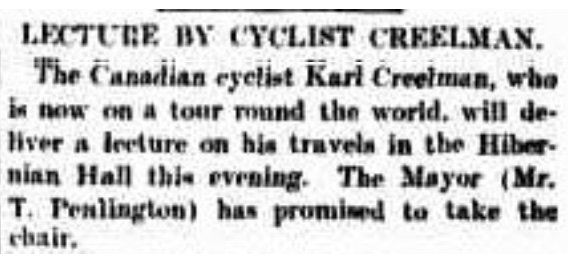Karl pedalled into Bundaberg at ten minutes to one on May 24th—just in time for a bite to eat before heading straight to the post office to have his travel book attested. No time wasted.
According to the local newspaper, he was warmly welcomed—offered a bottle of whisky, a glass of port, and a box of cigars in quick succession. But Karl declined them all with a simple, “No, thank you—I only want to have a yarn.” And so they yarned*.
The paper described him as a good-looking young man: clean-limbed, well-built, a little over medium height. He’d started his journey with no money and hadn’t accumulated much since, but he hoped to earn just enough in Queensland to buy himself tucker** as he toured the eastern part of the continent.
His gear told its own story—two suits of clothes and five pairs of boots already worn through. Strapped to his Red Bird bicycle was a blanket in the front, a ‘Jack Sheehy’** behind, and a bag tucked in the frame with papers and accessories. The bike, with its full load, weighed in at 52 pounds—and had held up well over the long journey, at least for now.
From Bundaberg, Karl cycled to Gladstone and reached Rockhampton on May 29th at 3:00 p.m. There, he was greeted by Mr. Theo Kingel, the Central Queensland agent for Red Bird bicycles, and escorted into town by a small procession of local cyclists—Rockhamptonites, as they were known. His bicycle was displayed at Kingel’s depot on Denham Street, new set of tires had just been fitted after the first set impressively lasted more than 5,000 miles.
Karl intended to stay in Rockhampton for a while and give a public lecture. But before I share that event with you (next week’s story), let me set the scene.
Rockhampton began as a boomtown—gold was discovered nearby in 1858, drawing some 15,000 people almost overnight. That same year, it was officially declared a town, and soon after, a bustling river port took shape to support the pastoral, cattle, and mining industries that fueled the local economy. By the mid-1860s, exports out of Rockhampton’s port even surpassed those from Brisbane.
Rockhampton grew steadily. This consistency helped preserve many of its elegant, heritage-listed public and commercial buildings—structures that still lend the town its distinctive charm. Wide verandas and ornate ironwork still grace its streets. Architectural gems, like the domed Customs House completed in 1901 and several buildings along Quay Street, speak to the town’s prosperity and civic pride.
One such building was the Hibernian Hall a new venue located at the corner of Bolsover and Derby Streets. The new Hall was built to replace an earlier structure to host community meetings, gatherings, and events. The hall was 75 feet long, 45 feet wide, and stood 17 feet tall.
The hall was officially opened on March 8, 1895 with a grand concert, and a banquet was held on March 17 (St. Patrick’s Day). The building featured a large hall with a stage, and was adorned with paintings of Irish scenery and busts of notable Irish figures. A notable feature was a cast of a female figure with a harp at her foot, symbolizing Ireland, placed on the apex of the roof facing Bolsover Street.
Karl’s lecture was scheduled for Friday, June 8th, at the newly built Hibernian Hall
The local paper advertised:
Carl M. Creelman (yes dear reader, the paper spelled his name incorrectly) of Nova Scotia, Canada, will deliver a lecture on his tour of 18,000 miles by land and sea, with many interesting and exciting incidents, in the Hibernian Hall on Friday next, 8th June. His Worship the Mayor will preside. Musical items by leading amateurs will precede the lecture. Admission 1s. Tickets to be had from all cycle agents.
A second notice appeared the day of the event:
LECTURE BY CYCLIST CREELMAN. The Canadian cyclist Karl Creelman, who is now on tour round the world, will deliver a lecture on his travels in the Hibernian Hall this evening. The Mayor (Mr. T. Penlington) has promised to take the chair.
Karl would soon step onto that stage, introduced by the mayor himself, and deliver his first lecture. How did it go? How was it received?
I’ll tell you in the next post.
*To yarn is a colloquial term to chat, or have a natter, for my british readers
** Tucker - food
***Jack Sheehy aka "billy can" is a small metal container, often used for boiling water or cooking food over a campfire.
If you are new to the Karl Chronicles, get caught up on our expedition around the world!
Start here: 200 highlights from 200Chronicles
Then get caught up on the rest of our journey, click here for more Karl Chronicles
Click here to check out my art store
The Karl Journey is now registered as an official expedition with the Royal Geographical Society

















